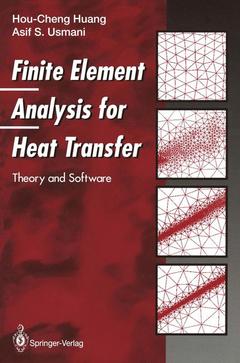Description
Finite Element Analysis for Heat Transfer, Softcover reprint of the original 1st ed. 1994
Theory and Software
Authors: Huang Hou-Cheng, Usmani Asif S.
Language: English
Keywords
calculus; finite element method; finite elements; heat transfer; modeling
52.74 €
In Print (Delivery period: 15 days).
Add to cart
Publication date: 01-2012
199 p. · 15.5x23.5 cm · Paperback
199 p. · 15.5x23.5 cm · Paperback
Description
/li>Contents
/li>Comment
/li>
This text presents an introduction to the application of the finite ele ment method to the analysis of heat transfer problems. The discussion has been limited to diffusion and convection type of heat transfer in solids and fluids. The main motivation of writing this book stems from two facts. Firstly, we have not come across any other text which provides an intro duction to the finite element method (FEM) solely from a heat transfer perspective. Most introductory texts attempt to teach FEM from a struc tural engineering background, which may distract non-structural engineers from pursuing this important subject with full enthusiasm. We feel that our approach provides a better alternative for non-structural engineers. Secondly, for people who are interested in using FEM for heat transfer, we have attempted to cover a wide range of topics, presenting the essential the ory and full implementational details including two FORTRAN programs. In addition to the basic FEM heat transfer concepts and implementation, we have also presented some modem techniques which are being used to enhance the accuracy and speed of the conventional method. In writing the text we have endeavoured to keep it accessible to persons with qualifications of no more than an engineering graduate. As mentioned earlier this book may be used to learn FEM by beginners, this may include undergraduate students and practicing engineers. However, there is enough advanced material to interest more experienced practitioners.
1 Introduction.- 1.1 Importance of Numerical Analysis of Heat Transfer.- 1.2 Reliability of Finite Element Analysis for Heat Transfer.- 1.3 Various Heat Transfer Problems.- 1.4 Objectives and Layout.- References.- 2 Governing Differential Equations.- 2.1 Introduction.- 2.2 Conduction.- 2.3 Convection.- 2.4 Radiation.- References.- 3 Finite Element Method.- 3.1 Introduction.- 3.2 Variational Principle and Rayleigh-Ritz Method.- 3.3 Galerkin Weighted Residual Method.- 3.4 Finite Element Method in Two Dimensions.- References.- 4 Temporal Discretisation for Heat Conduction.- 4.1 Introduction.- 4.2 Finite Element Discretisation of the Transient Conduction Equation.- 4.3 Recurrence Relations.- 4.4 Automatic Time Step Selection.- 4.5 Benchmark Example.- References.- 5 Phase Transformation.- 5.1 Introduction.- 5.2 The Stefan Problem.- 5.3 Numerical Methods for Modelling Phase Transformation.- 5.4 Benchmark Examples.- 5.5 Conclusion.- References.- 6 Adaptive Heat Transfer Analysis.- 6.1 Introduction.- 6.2 Error Estimation for Heat Conduction.- 6.3 Higher Order Approximation.- 6.4 Implementation of the Adaptive Procedure.- 6.5 Steady State Benchmark Example.- 6.6 Transient Analysis.- References.- 7 Effects of Convection in Heat Transfer.- 7.1 Introduction.- 7.2 Steady State Advection-diffusion.- 7.3 Transient Advection-diffusion.- References.- A Software Description for HEAT2D.- A.1 Introduction.- A.2 Glossary of Variable Names.- A.2.1 Main Variables.- A.2.2 Main Arrays.- A.2.3 Main Subroutines.- A.3 Program Overview.- A.4 Input Instructions.- A.5 Element Stiffness Calculations.- A.6 Phase Change Calculations.- A.6.1 Nodal Latent Heat Calculations.- A.6.2 Latent Heat Release for Each Iteration.- A.6.3 Correction of Temperatures after Each Iteration.- A.7 Documented Examples.- A.7.1 1-D Solidification Example.- A.7.2 Steady State Forced Convection Example Using the SUPG Method.- References.- B Software Description for HADAPT.- B.1 Introduction.- B.2 Glossary of Variable Names.- B.2.1 Main Variables for the Geometry and Mesh Data.- B.2.2 Additional Variables Used in This Program.- B.2.3 Additional Arrays Used in This Program.- B.2.4 New Subroutines Used in This Program.- B.3 Program Overview.- B.4 Input Instructions.- B.4.1 Geometry Data.- B.4.2 Mesh Density Data.- B.4.3 Example Data File.- B.4.4 Output Data.- B.4.5 Problem Data.- B.5 Error Estimate Calculations.- B.6 Documented Examples.- B.6.1 2-D Heat Conduction with Convective Boundary Condition.- B.6.2 Convection Dominated 2-D Heat Transfer.- B.6.3 1-D Solidification Example.
The use of finite elements for the modelling of heat transfer problems is described. Applicable in mechanical, civil as well as in materials engineering, it copes with heat transfer in virtually any medium including polymers and ceramics. The essential theory is covered and full implementational details given including two FORTRAN programs. HEAT2D, a program capable of steady and transient, linear and nonlinear analyses of diffusive and convective heat transfer and its adaptive version HADAPT are also presented with full instructions and documented examples.
© 2024 LAVOISIER S.A.S.




